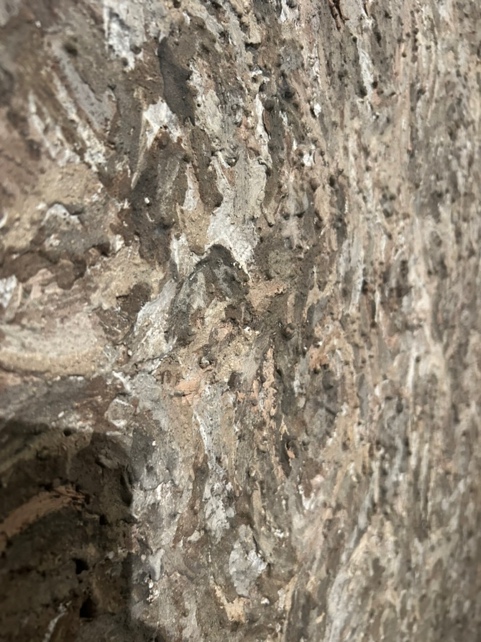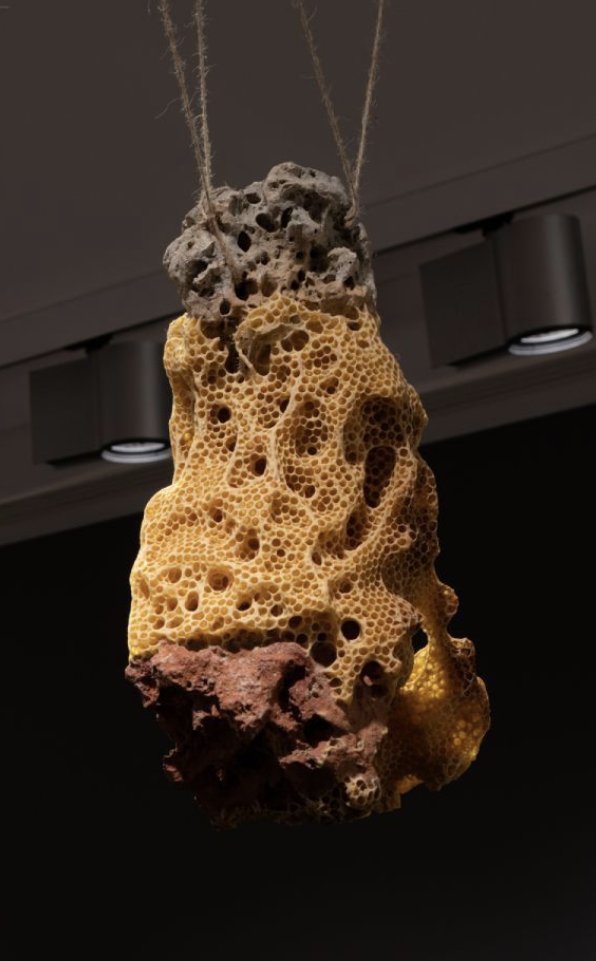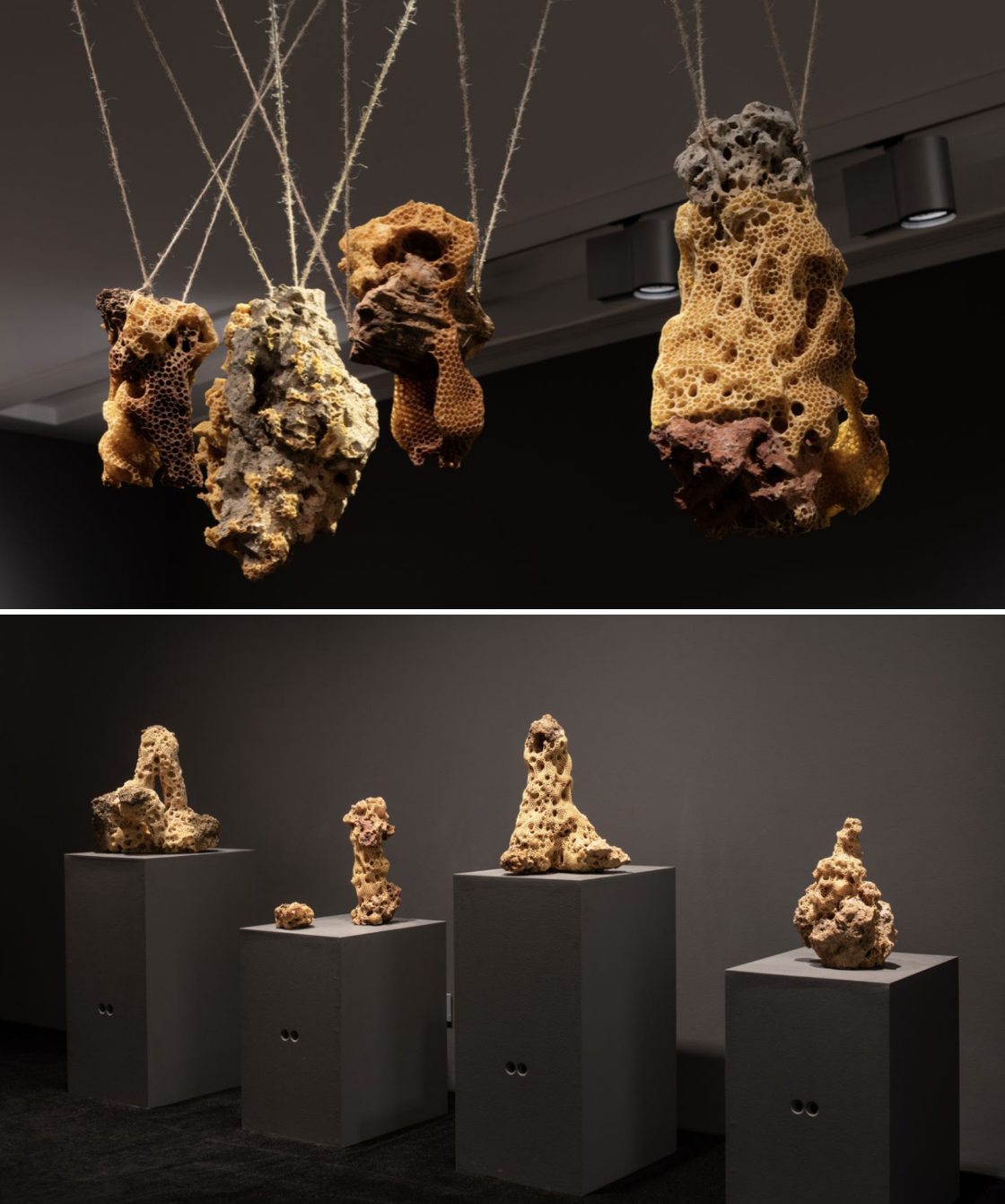Sympoietic Fabrics’ is an exhibition hosted by the Sursock Museum on display until the 25th of August 2024. It features the work of a Lebanese artist, Charbel Samuel Aoun, curated by Marie-Nour Héchaimé. The use of natural elements is a recurring theme in his work. Aoun heads on a journey of reconnection with nature, with some of his artworks depicting him as laboring to form this reconnection, giving us the sense that Aoun is almost atoning for the alienation of humanity from nature. To attend this exhibition, is to take part in a spatial experience that will leave the audience, if they dare reflect, changed for the better.

The exhibition is on the ground floor of the Museum, and is divided into two identical rooms facing each other across the entrance hall with a reception desk, which stands in the middle of these two rooms. Both rooms are completely black, and dimly lit with a warm orange light that illuminates each artwork individually (fig. 1). I began by entering the room on the right, which had different points of focus, the first being a mechanical installation that is made up of three sets of rocks, each with its own movement and rhythm. Each set produces a sort of “music” as a result of the rocks hitting and scraping each other, being pulled and pushed automatically by a mechanism. The vibration created with the tapping of the rocks is almost meditative. It is a 'music' we are no longer accustomed to hearing in our urban environment.

The second point of interest in the room, is a painting made of lime, sands, and ashes, that finds its ‘sister’ facing it in the opposing room (fig. 2). Both the paintings are made of dynamic patterns that Aoun etched out, tricking the eye and mind into believing there is movement, and even into feeling its surface without ever touching it. Aoun continues with the same materials used in the first part of the exhibition, the moving rocks, as he uses ashes and sands to create a rocky surface that gives a semblance of movement. The process of rock formation would usually take billions of years, and specific natural conditions, but it has been recreated by a man in a studio. Although Aoun attempts to provide an escape from the urban individualist world, he still plays into man’s attempt to control, which at first might seem paradoxical to the idea of reconnecting with nature, but the meaning of ‘sympoeitic’ is of collaborative creation, which leads us to the second room.

Leaving the deep black backdrop of the first room, into the pearly white of the reception, and back into the second room, equally as dark as the first, almost feels like a slap in the face. The first installation that caught my attention was four rocks each covered in a beehive, hanging by thread from the ceiling. When first approached, the smell of the dried-up honeycomb is almost shocking and revolting. These are paralleled with four pedestals on the opposite side of the room, each holding a rock also covered in honeycomb, that contain sensors at ankle level that, when activated, produce either jarring noises, or the soothing buzz of the bees that Aoun worked with to make these creations (fig. 3a-b). Both the hanging rocks and the ones on the pedestals parallel each other in their activation of our senses, one activates our sense of smell, and the other our hearing. And aggressively so, as the sound produced from the sensors in the pedestals catches the audience by surprise, and so does the smell of the honeycomb. This layout is not innocent or coincidental, these two sets are meant to be interacted with together. Further, the rocks hanging from the ceiling were moving, and slightly swinging as people moved past them, allowing for the audience to temporarily take part in the movement that is recurrent in this exhibition, and that is paralleled with the pedestals that require movement to activate the recordings.
Lined up on the wall are multiple small drawings that are abstract. You could almost make a figure or shape out in their chaos, but to no avail. Here Aoun toys with abstract lines to once again create a sense of movement, of purpose in the storm of existence.
A part of the exhibition I think deserved to be mentioned at the end, was four televisions that are hung on the wall in the first room, each playing a video depicting Aoun in his process of creation. One video is reminiscent of the pedestals in the second room, as Aoun brings the audience into the fold once more in his Baalbek installation, where passersby activate sound when walking past the ancient well, another where different people participate in a musical performance téléphone cassé style, a third where he throws himself into a spiritual exploration of the effects of the Beirut Port explosion of 2020. And a final video, that is the one I found most important, most jarring. Aoun collects clay and driftwood from a river in Bordeaux, France, which he then drags for hours across the city, only to then call on people to participate in the molding of the clay, to allow them at once to form the artwork, and to reconnect with the river and nature that the urban world has robbed them of. The video shows Aoun clearly struggling in dragging his load across the streets.

In this exhibition, Aoun reevaluates our severed connection with the natural world, and brings to light the violence we have done to ourselves in this separation. Visiting this exhibition, I was reminded of a quote by Mary Oliver; "You do not have to be good. You do not have to walk on your knees for a hundred miles through the desert repenting."1 This is often misunderstood. Oliver never intended to prohibit us from going on a journey of grief, rather she intends to convey the idea that one doesn't need to engage in extreme acts of penance to atone for their wrongdoings. She rejects the idea that suffering is necessary for redemption. I say to Aoun, just as Oliver said: "You do not have to walk on your knees for a hundred miles through the desert repenting".The wrongdoings of humanity are of colossal weight, and their ramifications will be felt by all inhabitants of the planet, and the planet itself for millennia to come. But it is not Aoun’s burden alone to venture on this journey of reconnection. I left the exhibition with a sense of calm, as if I had just meditated, having taken more away using my senses, than reading the abstracts on the wall. I also left the exhibition with the idea that only through collaboration, can we reconnect with the language of movement we lost, and atone for our wrongdoings... but most importantly, understand that it is an act we should not do alone. It is an act that should be done sympoeitically.
Exhibition Details
Marie-Nour Héchaimé, curator. Charbel Samuel Aoun - Sympoietic Fabric
29 February 2024 – 25 August 2024, Sursock Museum, Beirut.